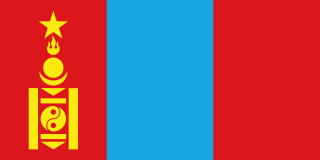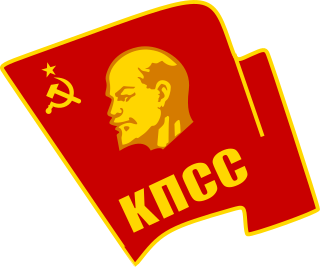
The Supreme Soviet of the Union of Soviet Socialist Republics was, from 1936 to 1991, the highest body of state authority of the Union of Soviet Socialist Republics (USSR), and based on the principle of unified power was the only branch of government in the Soviet state.

The Mongolian People's Republic was a socialist state that existed from 1924 to 1992, located in the historical region of Outer Mongolia under the Qing dynasty. It was officially recognized by the Nationalist government as independent from the Republic of China in 1946. Until 1990, it was a one-party state ruled by the Mongolian People's Revolutionary Party, and maintained close political and economic ties with the Soviet Union, as part of the Eastern Bloc.
The 1924 Constitution of the Soviet Union was the constitution of the Soviet Union adopted on 31 January 1924. According to British historian Archie Brown the constitution was never an accurate guide to political reality in the USSR. For example, the fact that the Communist Party played the leading role in making and enforcing policy was not explicitly mentioned in it until 1977.
The 1936 Constitution of the Soviet Union, also known as the Stalin Constitution, was the constitution of the Soviet Union adopted on 5 December 1936.
The 1977 Constitution of the Soviet Union, officially the Constitution of the Union of Soviet Socialist Republics, was the constitution of the Soviet Union adopted on 7 October 1977.

An index of articles related to the former nation known as the Soviet Union. It covers the Soviet revolutionary period until the dissolution of the Soviet Union. This list includes topics, events, persons and other items of national significance within the Soviet Union. It does not include places within the Soviet Union, unless the place is associated with an event of national significance. This index also does not contain items related to Soviet Military History.

Avel Safronovich Yenukidze was a prominent Georgian "Old Bolshevik" and, at one point, a member of the Central Committee of the All-Union Communist Party (b) in Moscow. In 1932, along with Mikhail Kalinin and Vyacheslav Molotov, Yenukidze co-signed the infamous "Law of Spikelets". In 1918 to 1935 Yenukidze served as the Secretary of the All-Russian Central Executive Committee and the Central Executive Committee of the Soviet Union.
The 16th Congress of the Russian Communist Party (Bolsheviks) was held during 26 June - 13 July 1930 in Moscow. The congress of the Russian Communist Party (Bolsheviks) was attended by 1,268 voting delegates and 891 delegates with observer status. It elected the 16th Central Committee.
The 18th Congress of the Russian Communist Party (Bolsheviks) was held during 10–21 March 1939 in Moscow. It elected the 18th Central Committee.

The Supreme Court of the Soviet Union, officially the Supreme Court of the USSR was the highest court of the Soviet Union during its existence. It was established on November 23, 1923 and was dissolved on January 2, 1992. The Supreme Court of the USSR included a Military Collegium and other elements which were not typical of supreme courts found in other countries, then or now. Its role, power and function evolved throughout the history of the USSR. The first chairman of the Supreme Court was Nikolai Krylenko.

The electoral system of the Soviet Union was varying over time, being based upon Chapter XIII of the provisional Fundamental Law of 1922, articles 9 and 10 of the 1924 Constitution and Chapter XI of the 1936 Constitution, with the electoral laws enacted in conformity with those. The Constitution and laws applied to elections in all Soviets, from the Supreme Soviet of the Soviet Union, the Union republics and autonomous republics, through to regions, districts and towns. Voting was claimed to be secret and direct with universal suffrage. However, in practice, between 1936 and 1989, voters could vote against candidates preselected by the Communist Party only by spoiling their ballots, or by voting against the only candidate, whereas votes for the party candidates could be cast simply by submitting a blank ballot. A person would be given a ballot by a clerk, and could immediately walk to the ballot box, and while there were booths in which one could strike the candidates they voted against off the ballot, this was easy to record and was not commonly done by voters.

The Government of the Union of Soviet Socialist Republics (USSR) was the executive and administrative organ of the highest body of state authority, the All-Union Supreme Soviet. It was formed on 30 December 1922 and abolished on 26 December 1991. The government was headed by a chairman, most commonly referred to as the premier of the Soviet Union, and several deputy chairmen throughout its existence. The Communist Party of the Soviet Union (CPSU), as "The leading and guiding force of Soviet society and the nucleus of its political system" per Article 6 of the state constitution, controlled the government by holding a two-thirds majority in the All-Union Supreme Soviet. The government underwent several name changes throughout its history, and was known as the Council of People's Commissars from 1922 to 1946, the Council of Ministers from 1946 to 1991, the Cabinet of Ministers from January to August 1991 and the Committee on the Operational Management of the National Economy from August to December 1991.

The All-Union Congress of Soviets was formally the supreme governing body of the Soviet Union from its formation until the adoption of its second constitution in 1936. The Congress of Soviets determined the general direction of all public bodies and elected the Central Executive Committee of the Soviet Union: a body which was accountable to, and held the powers of the Congress when the Congress was not in session. Despite its nominal authority, in practice the Congress served as a rubber-stamp for the Communist Party. With the 1936 Constitution, the All-Union Congress was replaced by the Supreme Soviet.

The All-Russian Congress of Soviets evolved from 1917 to become the supreme governing body of the Russian Soviet Federative Socialist Republic from 1918 until 1936, effectively. The 1918 Constitution of the Russian SFSR mandated that Congress shall convene at least twice a year, with the duties of defining the principles of the Soviet Constitution and ratifying peace treaties. The October Revolution ousted the provisional government of 1917, making the Congress of Soviets the sole, and supreme governing body. This Congress was not the same as the Congress of Soviets of the Soviet Union which governed the whole Soviet Union after its creation in 1922.

The Declaration and Treaty on the Formation of the Union of Soviet Socialist Republics officially created the Union of Soviet Socialist Republics (USSR), commonly known as the Soviet Union. It de jure legalised a political union of several Soviet republics that had existed since 1919 and created a new federal government whose key functions were centralised in Moscow. Its legislative branch consisted of the Congress of Soviets of the Soviet Union and the Central Executive Committee of the Soviet Union (TsIK), while the Council of People's Commissars composed the executive.

The Political Bureau of the Central Committee of the Communist Party of the Soviet Union, or Politburo was the highest political body of the Central Committee of the Communist Party of the Soviet Union and de facto a collective presidency of the USSR. It was founded in October 1917, and refounded in March 1919, at the 8th Congress of the Bolshevik Party. It was known as the Presidium from 1952 to 1966. The existence of the Politburo ended in 1991 upon the breakup of the Soviet Union.
Uraz Januzaquly Isayev was a Kazakh Soviet politician. He was prime minister of the Kazakh Autonomous Soviet Socialist Republic and the Kazakh Soviet Socialist Republic. He was a candidate member of the Central Committee elected by the 17th Congress of the All-Union Communist Party (Bolsheviks) from 1934 to 12 October 1937 and a full member until 31 May 1938. He was arrested and executed during the Great Purge. He was rehabilitated on 19 May 1956.
Supreme Soviet elections were held in the Ukrainian SSR on 26 June 1938 to elect deputies to the Supreme Soviet. They were held alongside elections to oblast councils and followed the national elections to the Supreme Soviet of the Soviet Union on 12 December 1937.
The Extraordinary 8th All-Union Congress of Soviets was held in Moscow from November 25 to December 5, 1936, on the last day of its work it approved the new constitution of the Soviet Union, according to which the supreme body of state power of the Soviet Union is a Supreme Soviet of the Soviet Union. Thus, this was the last Congress of Soviets.










